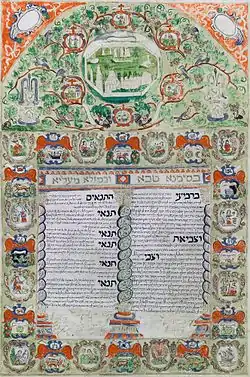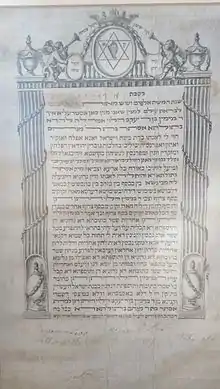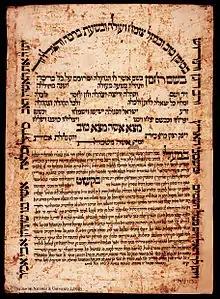Ketubah
A Ketubah (Hebrew: כְּתוּבָּה) is a Jewish marriage contract.[1] It is considered an integral part of a traditional Jewish marriage, and outlines the rights and responsibilities of the groom, in relation to the bride. In modern practice, the ketubah has no agreed monetary value, and is seldom enforced by civil courts, except in Israel.[2]

History
According to the Babylonian Talmud, the ketubah was enacted by Simeon ben Shetach[3] so that it might not be a light thing for a man to divorce his wife.[4] The enactment provides for a man's wife to receive a fixed sum of money, usually accruing from his property, in the event of his divorcing her or of his predeceasing her. Thirteenth-century rabbi, Aharon HaLevi, adds a different reason, writing: "Of the logic behind this one commandment, [we find] that the Torah has commanded us to perform an act before taking a wife, a matter that is intended to show that they are a couple united in wedlock before he lies down with her carnally, and that he not come upon her as one would do to a harlot, where there is no other act that precedes what goes on between them..."[5]
In any rate, the rabbis in ancient times insisted on the marriage couple entering into the ketubah as a protection for the wife. It acted as a replacement of the biblical mohar – the price paid by the groom to the bride, or her parents, for the marriage (i.e., the bride price).[6] The ketubah served as a contract, whereby the amount due to the wife (the bride-price) came to be paid in the event of the cessation of marriage, either by the death of the husband or divorce. The biblical mohar created a major social problem: many young prospective husbands could not raise the mohar at the time when they would normally be expected to marry. So, to enable these young men to marry, the rabbis, in effect, delayed the time that the amount would be payable, when they would be more likely to have the sum. The mechanism adopted was to provide for the mohar to be a part of the ketubah. Both the mohar and the ketubah amounts served the same purpose: the protection for the wife should her support by her husband (either by death or divorce) cease. The only difference between the two systems was the timing of the payment. A modern secular equivalent would be the entitlement to alimony in the event of divorce. The ketubah amount served as a disincentive for the husband contemplating divorcing his wife: he would need to have the amount in order to be able to pay to his wife.
Archaeological discoveries
The ketubah of Babatha, a 2nd century woman who lived near the Dead Sea, was discovered in 1960 in the Cave of Letters.[7]
Over two hundred ketubot were discovered, among other manuscripts, in the Cairo Geniza.[8] They date between the 6th and 19th centuries and, whilst many consist of plain text, there are examples that use decorative devices such as micrography[9] and illumination[10] to elaborate them.
Composition
Content

The content of the ketubah is in essence a two-way contract that formalizes the various requirements by Halakha (Jewish law) of a Jewish husband vis-à-vis his wife. The Jewish husband takes upon himself in the ketubah the obligation that he will provide to his wife three major things: clothing, food and conjugal relations,[11] and also that he will pay her a pre-specified amount of cash in the case of a divorce. The principal endowment pledged in a ketubah is 200 zuz for a virgin, and 100 zuz otherwise (such as for a widow, a convert, or a divorced woman, etc.).[12] Today, such pledges are made in local currency, and often exceed that of the principal. Thus the content of the ketubah essentially dictates the wife's rights in the marriage and provides for her security and protection. (Conservative Jews often include an additional paragraph, called the Lieberman clause, which stipulates that divorce will be adjudicated by a modern rabbinical court (a beth din) in order to prevent the creation of a chained wife.) The conditions written in the marriage contract may vary between communities, as in the case of the Yemenite ketubah, where the custom in Yemen was not to consolidate the different financial obligations, or pledges, into one single, aggregate sum as is practised by some communities. Rather, all financial obligations were written out as individual components, and had the same fixed sums for all persons.[13] The Chief Rabbinate in Israel has sought to bring uniformity to the ketubah, particularly where Jewish communities in the Diaspora had upheld conflicting traditions.[14]
As in most contracts made between two parties, there are mutual obligations, conditions and terms of reciprocity for such a contract to hold up as good. Thus said R. Yannai: "The conditions written in a ketubah, [when breached], are tantamount to [forfeiture of] the ketubah."[15] A woman who denied coitus unto her husband, a condition of the ketubah, was considered legal grounds for forfeiture of her marriage contract, with the principal and additional jointure being written off.[16]
Bat-Kohen variation
The Mishna and Talmud Bavli record that the "Beth-Din of Kohanim" would oversee that the Ketubah of a Bat-Kohen would contract the amount of four hundred Zuz (an increase from the standard amount of two hundred Zuz) in the event the Bat-Kohen would be given a Get (bill of divorce)[17] – the increase was written as the base amount due the Bat-Kohen and not as a bonus.[18]
The Talmud Yerushalmi opines that the Bat-Kohen who marries a non-Kohen receives that standard two hundred Zuz amount, as a penalty for not marrying within the greater family of Kohanim.[19]
Based on the research of A. Epstien, in his work "Toldot HaKetubah B'Yisrael", the recording of Four hundred Zuz in the Ketubah of the Bat-Kohen was well in effect during the Amora period, but from thence onward, no mentioning of the increased amount is found in Rabbinic sources.[20]
Design and language

The ketubah is a significant popular form of Jewish ceremonial art. Ketubot have been made in a wide range of designs, usually following the tastes and styles of the era and region in which they are made. Many couples follow the Jewish tradition of hiddur mitzvah which calls for ceremonial objects such as the ketubah to be made as beautiful as possible.
Traditional ketubot are not written in the Hebrew language, but in Aramaic, the lingua franca of Jews at the time ketubot became standardized. This was done in order to make sure the bride and groom understood the contract that was being signed. Many contemporary ketubot have translations into English or other vernacular languages or an accompanying vernacular text. Many Conservative Jews and other non-Orthodox Jews use ketubot written in Hebrew rather than in Aramaic. Others may use Aramaic ketubot but also have an additional official version in Hebrew.[21]
In recent years ketubot have become available in a variety of formats as well as the traditional Aramaic text used by the Orthodox community. Available texts include Conservative text, using the Lieberman Clause, Reform, Egalitarian and Interfaith texts. Some congregations have texts available for same sex couples too. In addition, Secular Humanist and Anniversary texts are also available today.
Usage
Role in wedding ceremony

In a traditional Jewish wedding ceremony, the ketubah is signed by two witnesses and traditionally read out loud under the chuppah. Friends or distant relatives are invited to witness the ketubah, which is considered an honour; close relatives are prohibited from being witnesses. The witnesses must be halakhically valid witnesses, and so cannot be a blood relative of the couple. In Orthodox Judaism, women are also not considered to be valid witnesses. The ketubah is handed to the bride for safekeeping.
Display
Ketubot are often hung prominently in the home by the married couple as a daily reminder of their vows and responsibilities to each other.
However, in some communities, the ketubah is either displayed in a very private section of the home or is not displayed at all. Various reasons given for this include the fact that the details specify personal details, prominent display may invite jealousy or fears of the evil eye. Historically, the ketubah specified whether the bride was a virgin. In Sephardic communities, it still specifies the actual contributions of the family to the new household and the divorce settlement; Ashkenazi communities have adopted the custom of having set amounts for all weddings.
Conditio sine qua non
According to Jewish law, spouses are prohibited from living together if the ketubah has been destroyed, lost, or is otherwise unretrievable.[22][23] In such case a second ketubah is made up (called a Ketubah De'irketa[24]), which states in its opening phrase that it comes to substitute a previous ketubah that has been lost.
Gallery of illuminated ketubot
 Marriage contract from Venice, 1765, Jewish Museum of Switzerland
Marriage contract from Venice, 1765, Jewish Museum of Switzerland.jpg.webp)
.jpg.webp)
.jpg.webp)
.jpg.webp)
.jpg.webp)


See also
- Judaism
- Jewish view of marriage
- Islamic marriage contract
- Quaker wedding (Christian marriage "by declaration" signed by all witnesses present at wedding)
- 2004 : Mariage juif à Mogador David Bensoussan & Asher Knafo, Éditions Du Lys, Montréal, ISBN 2-922505-15-4
References
- Rabbi Victor S. Appell. "I recently became engaged and my fiancée said we need to get a ketubah. Can you explain what a ketubah is?".
- "The Value and Significance of the Ketubah," Broyde, Michael and Jonathan Reiss. Journal of Halacha and Contemporary Society, XLVII, 2004.
- Babylonian Talmud, Shabbat 14b. Cf. Ketubbot 11a; 82b
- Maimonides, Mishneh Torah (Hil. Ishuth 10:7). Cf. Babylonian Talmud, Ketubbot 10a, where R' Simeon ben Gamaliel II held the view that the ketubah was a teaching derived from the Law of Moses.
- Aharon HaLevi (1958). Sefer ha-Chinuch (in Hebrew). Jerusalem: Eshkol. OCLC 233044594., mitzvah # 552
- Mentioned in Genesis 34:12, Exodus 22:16–17, Deuteronomy 20:7, Deuteronomy 22:29, Hosea 2:19–20
- Friedman, Mordechai A. (1996). "Babatha's "Ketubba": Some Preliminary Observations". Israel Exploration Journal. 46 (1/2): 55–76. JSTOR 27926417.
- "Search for 'ketubba'". Cambridge Digital Library. Retrieved 2 February 2016.
- "Legal document: ketubba (T-S 8.90)". Cambridge Digital Library. Retrieved 2 February 2016.
- "Legal document: ketubba (T-S 16.106)". Cambridge Digital Library. Retrieved 2 February 2016.
- "Kosher Sex". Judaism 101. Retrieved 29 August 2011.
- Mishnah (Ketubot 1:2–4)
- In the case of the tosefet (increment; additional jointure) written in the ketubah, if a virgin's ketubah was valued at 200 zuz, the increment was made out at one-hundred. If a widow's ketubah was valued at 100 zuz, the increment was made out at fifty. The increment was always half of the principal.
- Arusy, Rasson (1987). Halachic Decision-Making Regarding Conflict of Laws due to Inter-Communal Differences (Ph.D. Thesis) (in Hebrew). Tel-Aviv: Tel-Aviv University. pp. 313–323. OCLC 754748514., s.v. Enactments made by the Chief Rabbinate regarding the Ketubah (Hebrew title: התנגשות הדינים בפסיקת ההלכה הבינעדתית בישראל)
- Babylonian Talmud (Ketubbot 54b)
- According to the Midrash Rabba (Numbers Rabba 9:8), as well as Mishnah Ketubbot 7:6, whenever a married woman goes out publicly with her head uncovered, it is an act tantamount to exposing herself in public while naked, or what the Torah calls "erwah" (Heb. ערוה), and such an act would constitute grounds for a divorce without a settlement, as it is written: "…for he found in her a thing of nakedness" – (Heb. כי מצא בה ערות דבר) – Deut. 24:1.
- limited to a Bat-Kohen virgin whereas an Almanah (widow) would receive the standard one hundred Zuz
- Talmud Yerushalmi Ketuboth chap. 1 halacha 5, Bavli Ketuboth p. 12b
- Yerushalmi to Ketuboth 1:5 (p. 6a)
- Toldot HaKetubah B'Yisrael, p. 49
- Diamant, Anita (2001). The New Jewish Wedding. Simon & Schuster. p. 87. ISBN 9780743202558.
- Katz, Lisa. "What is a Ketubah?". about.com.
- Shulchan Aruch, Even Haezer 66:3
- "What happens if a ketubah is lost? - life cycle marriage intimacy women & judaism married life about". www.askmoses.com.
External links
![]() Media related to Ketubah at Wikimedia Commons
Media related to Ketubah at Wikimedia Commons


